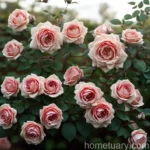Swamp Rose (Rosa palustris): A Native Wetland Plant
Introduction
In the world of wetland flora, one plant that stands out for its ecological importance and aesthetic appeal is the swamp rose (Rosa palustris). This beautiful flowering shrub is not only a delight to behold in its natural habitat but also serves multiple ecological functions. From providing wildlife habitat to contributing to wetland conservation, the swamp rose is a valuable component of wetland ecosystems. In this comprehensive guide, we will delve into the characteristics, cultivation, and ecological significance of the swamp rose. We will explore its cultural uses, habitat requirements, propagation, and maintenance, offering insights for both gardening enthusiasts and environmental conservationists. So, let’s embark on a journey to discover the captivating world of the swamp rose.
What is Plant: Swamp Rose (Rosa palustris)
The swamp rose, scientifically known as Rosa palustris, is a species of flowering shrub in the genus Rosa and the family Rosaceae. As the name suggests, this plant is commonly found in swampy or wetland habitats, thriving in the moist, acidic soils of marshes, bogs, and wet meadows. It is native to the eastern United States, where it contributes to the biodiversity and ecological functioning of wetland ecosystems. This deciduous shrub is characterized by its pink to deep rose-colored flowers, which bloom in late spring or early summer, attracting pollinators and adding a burst of color to wetland landscapes.
Key Takeaways – Swamp Rose (Rosa palustris)
- Scientific Name: Rosa palustris
- Common Name: Swamp Rose
- Family: Rosaceae
- Habitat: Wetlands, marshes, bogs, and moist meadows
- Flowering: Late spring to early summer
- Flower Color: Pink to deep rose
- Ecological Role: Wildlife habitat, wetland conservation, and biodiversity support
Characteristics of Rosa palustris
Understanding the characteristics of the swamp rose is essential for appreciating its unique features and ecological functions. Let’s explore the key traits that define Rosa palustris and make it a remarkable component of wetland ecosystems:
Swamp Rose Varieties
Rosa palustris is known for its exquisite beauty and diverse varieties, each with its own subtle variations in flower color, foliage, and growth habits. However, all varieties of Rosa palustris share common characteristics in terms of their ecological adaptations to wetland environments and their significance in supporting wetland biodiversity. Some notable varieties of swamp rose include:
- Rosa palustris ‘Plena’: Known for its double blooms and dense, bushy growth habit
- Rosa palustris ‘Suffulta’: Characterized by its deep pink flowers and vigorous growth
- Rosa palustris ‘Duplex’: Featuring delicate, semi-double flowers and a graceful appearance
Wetland Plants – Rosa palustris
As a wetland plant, Rosa palustris has evolved to thrive in the unique environmental conditions of wetlands. Its physiological and morphological adaptations enable it to withstand waterlogged soils, provide habitat for wetland wildlife, and contribute to the overall resilience of wetland ecosystems. The deep-reaching root system of Rosa palustris helps stabilize wetland soils and prevent erosion, making it an invaluable contributor to wetland conservation efforts.
Rosa palustris Habitat Requirements
One of the key characteristics of Rosa palustris is its specific habitat requirements, which are closely linked to its ecological role in wetlands. Understanding these habitat requirements is crucial for cultivating and conserving swamp roses in their natural or designed wetland environments. Some important habitat requirements of Rosa palustris include:
- Soil: Moist, acidic soils with good drainage
- Sunlight: Partial to full sun exposure
- Water: Regular access to moisture, ideally from natural rain or groundwater sources
- Climate: Well-adapted to the temperate climate of eastern North America
Growing Rosa palustris in Wet Conditions
Given its affinity for wet conditions, Rosa palustris presents an opportunity for cultivating and enhancing wetland landscapes. Whether in natural wetlands, constructed wetland gardens, or rain gardens, the swamp rose can thrive and contribute to the ecological integrity of these environments. Understanding the best practices for growing Rosa palustris in wet conditions is essential for successful cultivation and conservation outcomes.
Benefits of Planting Rosa palustris Swamp Rose
The benefits of planting Rosa palustris extend beyond its aesthetic appeal. This native wetland plant offers a range of ecological, cultural, and functional advantages, making it a valuable addition to wetland landscapes and restoration projects. Some notable benefits of planting Rosa palustris swamp roses include:
- Wildlife Habitat: Providing food, shelter, and nesting sites for birds, pollinators, and other wetland wildlife
- Wetland Conservation: Contributing to the restoration and conservation of wetland ecosystems
- Aesthetic Value: Adding beauty, color, and diversity to wetland landscapes
- Soil Stabilization: Helping prevent soil erosion and enhance the stability of wetland soils
- Educational Significance: Offering opportunities for wetland education, research, and public engagement
Culture
The cultural significance of Rosa palustris extends beyond its ecological role, as it holds historical, artistic, and symbolic value in various cultures. Understanding the cultural uses and symbolism associated with the swamp rose enriches our appreciation of this captivating wetland plant.
Uses
Rosa palustris has been valued for its diverse uses throughout history and across different cultures. From traditional medicine to artistic inspiration, the swamp rose has been woven into human cultures in multifaceted ways. Some common uses of Rosa palustris include:
- Medicinal Purposes: Traditional medicinal uses of swamp rose petals, hips, or extracts
- Aesthetic and Artistic: Inspirational subject for paintings, literature, and artistic expressions
- Symbolic Significance: Representation of love, beauty, and resilience in cultural symbolism
Water
Water plays a crucial role in the cultivation and survival of Rosa palustris. The specific water requirements of swamp roses in wetland habitats should be carefully considered to ensure their health and vitality. Key considerations related to water management for Rosa palustris include:
- Moisture Levels: Ensuring consistently moist soil without waterlogging
- Rainfall: Depending on natural rainfall or supplemental watering in drier periods
- Water Quality: Preference for natural, non-chlorinated water sources in wetland environments
Sunlight
As with most plants, sunlight is an essential factor for the growth and flowering of Rosa palustris. Understanding the sunlight preferences of swamp roses helps in selecting suitable planting locations and optimizing their performance. Key considerations related to sunlight for Rosa palustris include:
- Sun Exposure: Thriving in partial to full sun conditions
- Shade Tolerance: Adapting to varying light intensities in wetland habitats
- Orientation: Planting considerations for maximizing sunlight exposure
Fertilizer
In the context of wetland gardening and ecological conservation, the use of fertilizers for Rosa palustris should be approached with caution to avoid adverse effects on wetland ecosystems. Balanced and environmentally responsible fertilizer practices are essential for promoting the health and vigor of swamp roses. Some considerations for fertilizer use with Rosa palustris include:
- Organic Fertilizers: Preference for organic, slow-release fertilizers to minimize environmental impact
- Nutrient Balance: Ensuring a balanced blend of essential nutrients without causing nutrient imbalances in wetland soils
- Minimal Application: Practicing restraint in fertilizer application to avoid excessive nutrient runoff into wetlands
Soil
The soil composition and quality are critical factors in the successful cultivation of Rosa palustris in wetland environments. Understanding the specific soil requirements of swamp roses and their interactions with the broader wetland ecosystem is fundamental for promoting long-term plant health and ecological balance. Key considerations for soil management with Rosa palustris include:
- Acidic Soils: Thriving in acidic soil conditions typical of wetlands
- Drainage: Ensuring adequate drainage to prevent waterlogging and root rot
- Soil Amendments: Using organic matter and mulch to improve soil structure and fertility in wetland gardens
Pruning
Pruning is an essential horticultural practice for managing the growth, shape, and flowering of Rosa palustris in both natural and cultivated wetland settings. Proper pruning techniques help maintain the health and aesthetic appeal of swamp roses while promoting their ecological contributions to wetland environments. Some key considerations for pruning Rosa palustris include:
- Timing: Pruning in late winter or early spring to remove dead or damaged wood, promote new growth, and shape the plant
- Sanitation: Using clean, sharp tools to minimize the risk of disease transmission during pruning
- Selective Pruning: Removing spent flowers and shaping the plant to encourage bushy, vigorous growth and abundant flowering
Propagation
The propagation of Rosa palustris offers opportunities for expanding its presence in wetland conservation efforts, garden landscapes, and wildlife habitats. Understanding the methods of propagating swamp roses enables individuals, conservation organizations, and horticulturalists to contribute to the resilience and diversity of wetland ecosystems. Some common propagation methods for Rosa palustris include:
- Seed Propagation: Collecting, scarifying, and sowing seeds in a suitable germination medium for raising new Rosa palustris plants
- Cutting Propagation: Taking semi-hardwood or hardwood cuttings from healthy swamp rose plants and rooting them under favorable conditions
- Division: Dividing older clumps of Rosa palustris into smaller sections and replanting them to establish new growth
Container Popularity
In addition to its role in natural wetland habitats, Rosa palustris has gained popularity as a container plant, allowing individuals and gardeners to enjoy its beauty and ecological benefits in diverse settings. Growing Rosa palustris in containers presents unique opportunities and challenges that differ from cultivating it in natural wetland environments. Considerations for container cultivation of Rosa palustris include:
- Container Size: Selecting spacious containers to accommodate the robust growth and root development of swamp roses
- Soil Mix: Using well-draining, acidic soil mixes suitable for Rosa palustris in container gardening
- Water Management: Balancing moisture levels and drainage in containers to mimic natural wetland conditions
Common Diseases
Like all plants, Rosa palustris is susceptible to certain diseases and disorders that can impact its health and vitality. Being aware of common diseases affecting swamp roses and their appropriate management strategies is essential for promoting plant resilience and conserving wetland ecosystems. Some common diseases of Rosa palustris include:
- Powdery Mildew: Fungal disease causing powdery white growth on leaves
- Black Spot: Fungal infection leading to dark spots on foliage and premature leaf drop
- Rust: Fungal disease resulting in orange, powdery pustules on leaf undersides
- Botrytis Blight: Fungal infection causing gray mold on flowers and buds
Disease Diagnosis
Diagnosing diseases in Rosa palustris involves careful observation of plant symptoms, understanding the environmental conditions, and, if needed, seeking professional assistance for accurate identification and management of diseases. Key steps in disease diagnosis for Rosa palustris include:
- Symptom Identification: Noting the specific symptoms, including leaf discoloration, spots, or unusual growth patterns
- Environmental Assessment: Considering factors such as moisture, humidity, and overall plant health
- Consultation: Seeking guidance from plant pathologists or horticultural experts for accurate disease diagnosis and treatment recommendations
Common Pests
In addition to diseases, Rosa palustris may face challenges from various pests that can affect its overall vigor and flowering potential. Understanding the common pests that target swamp roses and implementing integrated pest management strategies are essential for maintaining plant health and supporting wetland ecosystems. Some common pests affecting Rosa palustris include:
- Aphids: Small, sap-sucking insects that can distort new growth and excrete honeydew on leaves
- Japanese Beetles: Chewing insects that feed on foliage and flowers, causing visible damage
- Spider Mites: Microscopic pests that feed on plant juices, leading to stippled or discolored leaves
- Cane Borers: Insect larvae that bore into rose canes, causing dieback and weakening the plant
Botanist’s Tips
As botanists and plant enthusiasts, there are several tips and recommendations for cultivating and conserving Rosa palustris in wetland environments. These insights draw on scientific knowledge, practical experience, and a deep appreciation for the ecological significance of the swamp rose. Some valuable botanist’s tips for Rosa palustris include:
- Native Plant Landscaping: Incorporating Rosa palustris in wetland landscaping and restoration projects for ecological resilience
- Habitat Mimicry: Designing wetland gardens and rain gardens to mimic natural Rosa palustris habitats for optimal growth and ecological benefits
- Wildlife Conservation: Recognizing the role of Rosa palustris in supporting wetland wildlife and considering its broader ecological impact
- Educational Outreach: Promoting awareness of Rosa palustris and its wetland conservation significance through educational programs and public engagement
Fun Facts
Uncovering the intriguing aspects of Rosa palustris through fun facts and lesser-known details adds a layer of fascination to this remarkable wetland plant. From its historical uses to ecological interactions, various aspects of the swamp rose make it a subject of interest and appreciation. Some fun facts about Rosa palustris include:
- Historical Medicine: Use of swamp rose petals in traditional medicine for their astringent and aromatic properties
- Wildflower Gardens: Rosa palustris as an attractive wildflower for wetland and native plant gardens
- Hybridization Potential: Exploration of Rosa palustris hybridization for developing new wetland-adapted rose varieties
- Folklore and Symbolism: Representations of Rosa palustris in regional folklore and cultural narratives related to wetland environments
Links to External Resources
To further explore the world of Rosa palustris and its role in wetland conservation, gardening, and ecological restoration, the following external resources offer valuable insights and practical guidance:
- Wetland Plants for Attracting Wildlife
- Wetland Restoration and Plant Selection
- Native Plant Landscaping for Biodiversity
- Wetland Conservation and Ecosystem Services
- Rose Hybridization and Breeding
As we conclude this comprehensive guide to the swamp rose (Rosa palustris), we invite you to appreciate the ecological richness, cultural significance, and horticultural potential of this remarkable wetland plant. Whether you are a wetland conservationist, a garden enthusiast, or a curious learner, the swamp rose embodies a story of resilience, beauty, and ecological interconnectedness in the captivating world of wetland flora.















